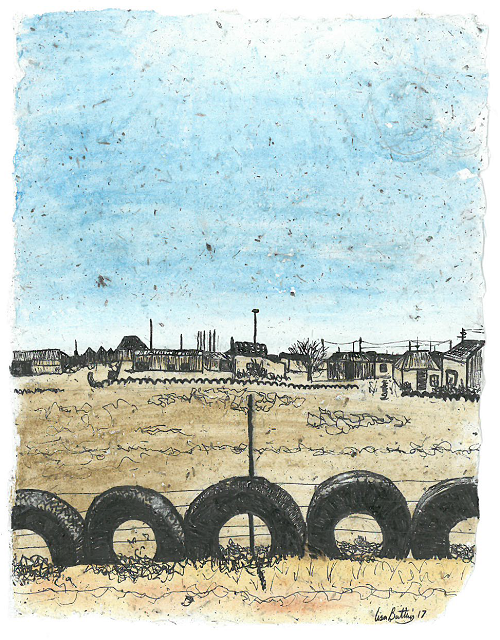Boingboing blogs from… Leandra
Co-produced Film Premier in Leandra and visit to the RYSE Project in Secunda – October 2017
by Lisa Buttery, Boingboinger
 Hey there, Lisa from Boingboing here, writing from South Africa. I arrived here on Sunday 1st October 2017, along with some other Boingboing team members. I’m feeling truly blessed to be able to work here for a third and final time this year; South Africa is the furthest I’ve ever travelled and working here is a really big deal for me. Ever since I returned home from my first trip in April, I couldn’t wait to come back and meet up with the young co-researchers from Leandra again. They are so knowledgeable, welcoming and friendly, it’s been such a privilege to work alongside them on this project.
Hey there, Lisa from Boingboing here, writing from South Africa. I arrived here on Sunday 1st October 2017, along with some other Boingboing team members. I’m feeling truly blessed to be able to work here for a third and final time this year; South Africa is the furthest I’ve ever travelled and working here is a really big deal for me. Ever since I returned home from my first trip in April, I couldn’t wait to come back and meet up with the young co-researchers from Leandra again. They are so knowledgeable, welcoming and friendly, it’s been such a privilege to work alongside them on this project.
On Monday morning we drove back to Leandra for our final visit of the project. This time we’re joined by Josh, a young apprentice from Blackpool HeadStart in the UK, who has joined us in the capacity of a young co-researcher with experience of resilience-based practices. The Leandran co-researchers began turning up at the community hall and we happily greeted each other in the customary South African way of saying, “Hi! How are you?” Everyone was friendly and keen to meet Josh.


As everyone settled down in the hall, thanks were given by project manager, Mosna, and Richard from Khulisa Social Solutions. Our South African colleague, Selogadi, a talented young theatre facilitator and activist (you can read about the Resilience Forum she ran in Brighton), gathered the audience around and introduced the film to everyone. The day was a chance for the young co-researchers to watch and celebrate their film. If you’ve been following our blogs, or tuning into our social media, you might already know that earlier this year we spent some days together in Leandra doing art and theatre workshops. About a month later we returned to share what we had found from the research together, and film the co-researcher’s ideas about how their community could be better supported to become even more resilient to the challenges drought brings. If you haven’t already checked them out there are plenty of previous blogs (like our blog about the arts workshops or the one about the theatre workshops) with lots of pictures and films to illustrate. There were lots of eager, curious friends and family members of all ages joining us today, waiting to see the stars of the film on the big screen. I was anxiously hoping they would be happy with the fruits of all our combined hard work.
The room fell quiet in anticipation and the film began to play. I’m pretty sure not everyone in the room was able to read all the subtitles (for some, English is their 7th or more spoken language!) but as I noticed the audience’s reactions I saw lots of concentration. As soon the first of the actors appeared on the screen expressions turned to smiles and you could feel an instant buzz of excitement fill the hall. Throughout the film screening there was a mixture of serious feelings and concern regarding the very real, scary challenges that drought brings to the community, and hopeful smiles at the suggestions and ideas the co-researchers have skilfully brought to life on camera.
At the end of the film, the room erupted into applause and cheering. Soon after that everyone whooped and cheered again for the co-researchers as one by one they came to the front of the hall to accept their vouchers and co-researcher certificates from the University of Brighton and Khulisa, their community organisation.

 The event was ended with a traditional South African meal being served up for everyone and live entertainment in the form of an amazing performance of singing, dancing and drumming by the fabulous Umdzabu Cultural Group. The day was a fantastic end to a wonderful project but excitingly for me, this is just the beginning of my trip.
The event was ended with a traditional South African meal being served up for everyone and live entertainment in the form of an amazing performance of singing, dancing and drumming by the fabulous Umdzabu Cultural Group. The day was a fantastic end to a wonderful project but excitingly for me, this is just the beginning of my trip.
Below you can watch a clip of their performance:
We left our hotel the following morning to visit another nearby township. On arrival we met up with Professor Michael Ungar, with colleagues from Pretoria University including Professor Linda Theron and young people from the RYSE project – Linda is leading the South African element of the project and Mike is leading the Canadian arm of it. We’re here to make connections and share learning about the co-research we are doing in both projects. Both communities we are working in seem quite similar in many ways, lots of the homes and shops look similar and many of the challenges we’ve learned about in Leandra are present here too. Both of our multinational projects are focused on young people’s resilience to environmental challenges, ours being focused on resilience to drought in Leandra, and the RYSE project in Secunda is focused on resilience to oil and gas production and climate change as active stressors on young people’s lives.
After a quick greeting and stretch of our legs near a sports field, we got back into the car joined by a new friend and tour guide who lives here in Secunda. It’s not far from where we’ve been doing our research in Leandra, in fact apparently lots of young people from Leandra actually go to schools here in Secunda. The township is split into 22 areas called extensions and extension one is the oldest, our guide explains. He tells us lots about what life for the residents of Secunda is like on our journey into the streets of the township. I would have liked to have had a tour like this of Leandra before starting our own project as I think it would have been a good way of learning a bit more about the everyday lives of the co-researchers who live there.

One thing that strikes me is that when you Google the places we’ve worked in this year there’s very little information about them (mostly I found our own blogs and a few sentences and figures on Wikipedia.) People back home I know tend to think of South Africa as a beautiful country where you can go on a safari to see the big 5, and usually assume that things have vastly improved for everyone here since apartheid times. But the sad reality is that life in these townships probably isn’t all that different today from how it’s always been.

As we drive deeper into the township we pass all sorts of different homes, they range from small windowless shacks crafted from corrugated metal, rusted and corroded by acid rain, right the way through to a small handful of large gated off homes that look quite posh to me. Our youth guide informs us that this township is a bit better off than Leandra because more people have jobs here. There’s a multitude of hair salon shacks, market stalls, stands selling fruit and vegetables and all sorts of shops. We pass smoking heaps of rubbish, an ATM machine that we’re assured doesn’t contain any cash, an orphanage that only opens during the day. Animals are freely roaming, people are going about their day to day business, hanging out and getting on with their lives. Posters are plastered side by side, one over another in almost every available space throughout the community, advertising backstreet abortions, penis creams and love spells. When I ask about them, our guide tells us that abortion is trending here. Some homes and spaces are decorated beautifully with elaborate paintings, murals, symbols, and skilfully crafted doors. There aren’t many other white people here apart from us so naturally we attract some curious looks, waves and attention.
Here is a slide show of some more of my photos:
I feel conflicted whilst documenting Secunda. There seems to be a sort of strange trend these days, following the success of films like “Slumdog Millionaire” and “District 9”, in poorer communities all over the world where tourists pay to go on tours of slums or townships, sometimes to put their own lives into perspective. I’m certainly not here to do that, I’m cautious to be as respectful as possible as a visitor in these communities. I do this in the hope that I can show the world that these people and places are here, that this is the reality behind those few short sentences on Wikipedia. Personally, I still have so many more questions about what life is really like here. I’d definitely need to spend longer than our hour long journey through the community to find the answers to those questions.
I love South Africa and its people; the wildlife and natural beauty is stunning, but the threats to the environment and extremes of inequality you see every day here are heart-breaking. It’s a struggle emotionally for us to end up later in the afternoon, just minutes down the road, at a huge palace-like casino that wouldn’t look out of place in Disneyland for a quick toilet and lunch stop.
Keep an eye out for upcoming blogs from other Boingboingers about the rest of our most recent trip to South Africa.
 Illustration of Leandra by Lisa Buttery
Illustration of Leandra by Lisa Buttery



